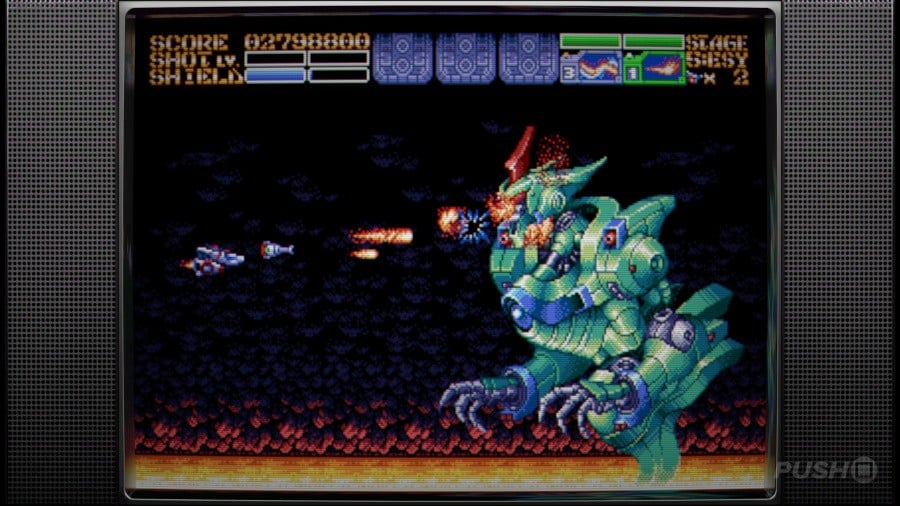
Yuzo Koshiro, a well-known expert in creating music for the SEGA Genesis, was expected to deliver something special when he began working on a new shoot ’em up game designed for the 16-bit console.
Earthion isn’t just a loving tribute to classic space shooters – it’s truly among the best, standing alongside genre giants like R-Type and Gradius.
The game skillfully balances nostalgia with modern tastes, successfully appealing to both longtime fans and new players.
The game features a shield that recharges, and it’s tied to how powerfully you shoot. Getting hit weakens your shield, but unlike old arcade games, it doesn’t immediately end the game – you can still keep playing.
You fly a powerful ship built from the wreckage of alien invaders, and you’re one of the last hopes for Earth. With half of humanity fleeing to Mars, our planet is vulnerable to attack.

You’ll battle your way through eight exciting levels filled with the wreckage of a huge space war. You’ll race to escape a quick alien enemy and put your weapons to the test against a powerful god – just another day for a typical anime hero!
Okay, so the way weapons work in this game is pretty cool. You’ve got your regular blaster, but you can also find awesome power-ups like rocket launchers or spread lasers to mix things up. The more energy I collect, the stronger *both* my main weapon and the special pick-ups get. But watch out! Getting hit actually weakens them, so I gotta play smart and dodge those attacks!
Throughout each level, you can find Automaton Pods which can be used to unlock new power-up slots or improve your shields and shooting ability. This lets you customize your experience and play the game your way, and a password system allows you to save and continue your progress.
Using these passwords can slightly ease the challenge of the Hard and Hotshot difficulties, but it’s your choice whether to use them. Players who want a truly challenging experience might prefer to start each playthrough without them.

Koshiro truly showcased his skill with the classic Yamaha YM2612 sound chip, and this work is considered one of his finest achievements.
The music is upbeat and catchy, just like you’d expect from the composer of Streets of Rage. However, it also feels epic and grand, perfectly fitting the science fiction world of the game. Combined with deliberately retro sound effects – like static-filled voice clips and simple drum machines – it creates a fantastic and surprisingly effective soundscape.
The game’s pixel art, skillfully crafted by Makoto Wada, a veteran of the series, is also noteworthy. It features striking backgrounds and impressively large enemies that dominate the screen.
The game plays a classic 16-bit game using an emulator on the PS5, with a physical cartridge version planned for SEGA consoles in 2026. It’s remarkable that a small, two-person team was able to achieve so much with the original 37-year-old game code, thanks to today’s development tools.

The emulator lets you adjust how the game looks, like adding scanlines to mimic old CRT screens. However, you can also choose to see the original, classic pixel art if you prefer.
Caravan mode provides extra gameplay after finishing the main story, with unique time and score-based challenges. However, the game’s content is relatively short – you can experience most of it in just a few hours.
The PlayStation controls feel a bit strange because they don’t consistently use either the traditional Japanese button layout (where Circle confirms selections) or the more familiar Western layout (where Cross or X confirms). However, this isn’t a major issue.
Read More
- The Most Jaw-Dropping Pop Culture Moments of 2025 Revealed
- Ashes of Creation Rogue Guide for Beginners
- ARC Raiders – All NEW Quest Locations & How to Complete Them in Cold Snap
- Best Controller Settings for ARC Raiders
- Where Winds Meet: How To Defeat Shadow Puppeteer (Boss Guide)
- Ashes of Creation Mage Guide for Beginners
- Where Winds Meet: Best Weapon Combinations
- My Hero Academia Reveals Aftermath Of Final Battle & Deku’s New Look
- Hazbin Hotel season 3 release date speculation and latest news
- Netflix’s One Piece Season 2 Will Likely Follow the First Season’s Most Controversial Plot
2025-09-21 12:07